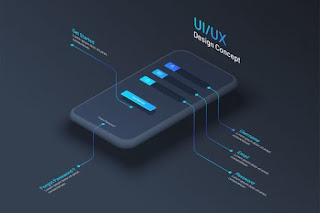Introduction: In today’s digital age, where user experience reigns supreme, the realm of design and UI/UX (User Interface/User Experience) has become indispensable. From the early days of basic web interfaces to the complex, intuitive applications of today, the landscape of design and UI/UX has evolved significantly. In this blog, we’ll delve into the evolution of design and UI/UX in the United States, exploring the trends, innovations, and future prospects that shape this dynamic field.
The Evolution of Design and UI/UX: The journey of design and UI/UX in the USA can be traced back to the advent of the internet. In the early stages, websites were static and functional, with basic layouts and minimal interactivity. However, as technology advanced and user expectations grew, the demand for more engaging and user-friendly experiences became evident.
The emergence of mobile devices further transformed the landscape, prompting designers to adapt their strategies to accommodate smaller screens and touch interfaces. This led to the rise of responsive design, which aimed to provide a seamless experience across various devices and screen sizes.
As the internet continued to evolve, so did the expectations of users. Today, consumers expect not only functionality but also aesthetics and usability. This has given rise to the concept of UI/UX design, which focuses on creating interfaces that are not only visually appealing but also intuitive and easy to navigate.
Trends and Innovations: Several trends and innovations have emerged in the realm of design and UI/UX, shaping the way we interact with digital products and services. Some of the notable trends include:
- Minimalism: The minimalist design philosophy, characterized by clean lines, whitespace, and simplicity, has gained popularity in recent years. This approach focuses on stripping away unnecessary elements to create a more focused and streamlined user experience.
- Microinteractions: Microinteractions are subtle animations or feedback loops that enhance the user experience by providing visual cues and feedback. These small details can make a significant difference in how users perceive and interact with a product.
- Voice User Interfaces (VUI): With the growing popularity of voice-activated devices like smart speakers and virtual assistants, VUI design has become increasingly important. Designers must consider factors such as natural language processing and conversational flow to create seamless voice-driven experiences.
- Dark Mode: Dark mode, which switches the color scheme of an interface to darker tones, has become a popular feature in many applications and websites. Not only does it reduce eye strain in low-light environments, but it also adds a sleek and modern aesthetic to the design.
Future Prospects: Looking ahead, the future of design and UI/UX in the USA is promising, driven by advancements in technology and evolving user expectations. Emerging technologies such as augmented reality (AR), virtual reality (VR), and artificial intelligence (AI) are poised to revolutionize the way we interact with digital interfaces.
AI-powered personalization will enable designers to create more tailored experiences based on user preferences and behavior, while AR and VR will open up new possibilities for immersive and interactive interfaces. Additionally, the continued integration of design and development processes, such as the adoption of design systems and component libraries, will streamline workflows and foster collaboration across teams.
Conclusion: In conclusion, the evolution of design and UI/UX in the USA has been marked by continuous innovation and adaptation to changing technologies and user demands. From the early days of static websites to the immersive experiences of tomorrow, designers play a crucial role in shaping the digital landscape and enhancing the way we interact with technology. By staying abreast of emerging trends and embracing new technologies, designers can continue to create experiences that delight and inspire users for years to come.
Certainly! Let’s delve deeper into some specific aspects and examples within the realm of design and UI/UX in the USA:
- Accessibility: With an increasing focus on inclusivity, designers are prioritizing accessibility in their interfaces. This includes considerations for users with disabilities, such as providing alternative text for images, ensuring keyboard navigation, and implementing color contrast ratios to accommodate individuals with visual impairments.
- Design Systems: Design systems have emerged as a powerful tool for ensuring consistency and scalability across digital products. By establishing a centralized repository of reusable components, styles, and guidelines, design teams can streamline their workflow and maintain brand coherence across various platforms and touchpoints.
- Gestural Interfaces: With the proliferation of touchscreen devices, gestural interfaces have become ubiquitous in modern UI/UX design. From swiping and pinching to tapping and dragging, designers are leveraging gestures to create more intuitive and immersive experiences that mimic real-world interactions.
- Data Visualization: In an era of big data, effective data visualization has become essential for conveying complex information in a digestible format. From interactive charts and graphs to dynamic infographics, designers are employing various techniques to present data in a visually engaging and meaningful way.
- Emotional Design: Recognizing the emotional impact of design, designers are increasingly incorporating elements of emotional design to evoke specific feelings and responses from users. Whether through the use of color psychology, storytelling, or microcopy, emotional design can help forge deeper connections and foster positive user experiences.
- Responsive Typography: As typography plays a pivotal role in shaping the readability and visual hierarchy of interfaces, designers are adopting responsive typography techniques to ensure optimal legibility across different devices and screen sizes. This includes the use of fluid typography, variable fonts, and viewport-based scaling to adapt text to varying contexts.
- Design for Sustainability: With growing concerns about environmental sustainability, designers are embracing eco-conscious practices in their work. This includes considerations for energy efficiency, material selection, and waste reduction, as well as advocating for sustainable design principles within the industry.
- Cross-Platform Design: With users accessing content across a multitude of devices and platforms, designers are focusing on creating seamless cross-platform experiences. By adopting a multi-platform approach and leveraging technologies such as responsive design and adaptive layouts, designers can ensure consistency and usability across different environments.
- Interactive Storytelling: In an age of immersive digital experiences, interactive storytelling has emerged as a powerful tool for engaging audiences. By combining elements of narrative with interactive elements such as animations, parallax scrolling, and branching pathways, designers can create compelling narratives that captivate and immerse users.
- Ethical Design: In light of growing concerns about privacy, data security, and digital ethics, designers are placing greater emphasis on ethical considerations in their work. This includes transparency in data collection practices, respect for user consent, and designing with empathy and inclusivity in mind.
- Continuous Iteration: In the fast-paced world of digital design, iteration is key to staying ahead of the curve. Designers are embracing agile methodologies and rapid prototyping techniques to iterate quickly and gather feedback from users, allowing for continuous improvement and refinement of their designs.
Conclusion: The field of design and UI/UX in the USA is characterized by constant innovation, driven by evolving technologies, changing user expectations, and a commitment to creating experiences that are both functional and delightful. By embracing emerging trends, leveraging new technologies, and prioritizing user needs, designers can continue to push the boundaries of creativity and shape the future of digital interactions.





